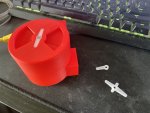GBrown
New member
I've been researching temperature control modules for my Louisiana Grill Kamado and I stumbled upon someone recommending Heatermeter. I was fascinated by the device and highly interested in the project. After a couple hours of research, I still have some beginner questions.
Right now I'm looking to get:
Right now I'm looking to get:
- HeaterMeter 4.3 Soldered w/ blower
- 12 Volt Power Supply
- Case for HeaterMeter
- Pro-Series® High Temp Air Probe With Grate Clip
- Raspberry Pi Zero-W
- SD Card (Already have)
- Is there anything else I will need to complete my build?
- Plate to attach to grill? Is it best to just get a thin piece of sheet metal and cut it to size?
- What's this Adapt-A-Damper device? I see a lot of talk about it, but it's not listed on the soldered kit page as being either included or not included (implying I don't need one???)
- How does the soldered kit interface with the Raspberry Pi?
- Does this device also adjust temp based on food temp? Will getting a food probe in addition to an ambient probe be beneficial?
- Is the term "pit probe" the same as an ambient probe?
- I don't have any soldering experience. Does the soldered kit require any additional soldering (such as soldering on the blower)?
- Is there an expected time frame on when other case colors will become available? I think I like the grey best, so not a huge issue. More just wondering.
- What about LCD colors? I saw more examples in the Wiki, but it looks like only black on white is the current offering.




